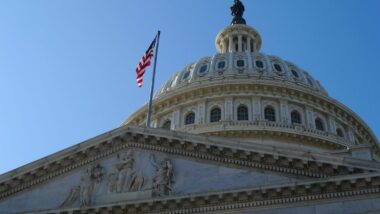The Infrastructure Investment and Jobs Act and the CHIPS and Science Act represented historic wins for manufacturers over the past two years, and the NAM remains hyper focused on helping policymakers maximize these massive investments to support competitiveness across the supply chain.
The NAM led advocacy for both of these pieces of legislation, and the NAM’s “Competing to Win” policy roadmap continues to guide policymakers in resolving unprecedented supply chain challenges.
Critical Highlights:
As outlined in our Competing to Win agenda, and our Building to Win infrastructure proposal, the NAM’s solutions have helped policymakers pass bipartisan legislation and helped manufacturers navigate supply chain bottlenecks and execute on critical infrastructure projects. Below are a few examples of these legislative milestones:
Bridges and Roads: Secured by the IIJA, $350 billion in federal aid highway funding is being allocated to states for road, bridge and infrastructure projects of local significance and benefit. The Federal Highway Administration allocated nearly $60 billion to support state projects, an increase of more than $15 billion from 2021. Funding for the federal bridge improvement program increased by 391%.
Permitting: Agency environmental and permit review processes have been modified by codifying One Federal Decision, a policy within the IIJA that streamlines previously duplicative reviews and sets firm timelines for approval and response to review applications for major projects.
Ports and Maritime: Through the IIJA, $17 billion is being directed to new port infrastructure, waterways maintenance and marine facility upgrades. Since the passage of IIJA, nearly $1 billion in Port Infrastructure Development Grants has already been announced by the U.S. Department of Transportation to provide much-needed improvements to U.S. maritime sites, improving operations and updating management systems to address cargo and goods movement supply chain challenges.
Electric Vehicles and EV Infrastructure: A new $7.5 billion National Electric Vehicle Infrastructure program has been established through the IIJA, which has already started to build out a national charging network that includes power transmission development and charging station infrastructure and contains $2.5 billion for publicly accessible alternative fuel infrastructure opportunities (i.e. hydrogen fuels, natural gas fuels, Alternative Fuel Corridors in communities).
Semiconductors: The CHIPS and Science Act included funding for programs aimed at supporting key areas of supply chain resilience, specifically supporting scaled chips production, the STEM workforce, advanced technology development, excavation of critical minerals, clean energy and more.
Shipping: The bipartisan Ocean Shipping Reform Act of 2022 included immediate regulatory changes to address port congestion and competition issues in ocean shipping. The act specifically included immediate regulatory changes to the process by which ocean carriers document, invoice and charge manufacturers detention and demurrage fees through a maritime cargo process. These changes require specific information collection and sharing within a reasonable timeframe for dispute resolution; enhanced funding to address shipper disputes; created anti-retaliatory mechanisms to prevent future shipping impediments; and directed the Federal Maritime Commission to advance regulation related to ocean carriers’ refusal to negotiate vessel space.
Keeping Up the Fight:
These historic and bipartisan gains must continue. The NAM is committed to being at the center of the solutions across the transportation supply chain to enforce infrastructure investment and generate the economic growth needed to protect America’s competitiveness. Here’s what we’re driving:
Permitting reform: Keep improving the broken permitting process to decrease time-consuming reviews and eliminate burdensome costs.
Project execution: Clear the extensive backlog of essential infrastructure projects that are already in the planning process and awaiting final approval.
Broader regulatory and permitting reform: streamline regulatory agencies’ processes so that key transportation projects don’t get tripped up by more red tape.
Flexibility: Public–private partnerships and innovative collaboration between industry and government should continue to play a large role in these infrastructure upgrades, but not every approach is universal. Policymakers should maintain key funding sources and keep the federal government involved but retain a results-oriented focus to improve our nation’s infrastructure.
 Below are related NAM resources we encourage you to review:
Below are related NAM resources we encourage you to review: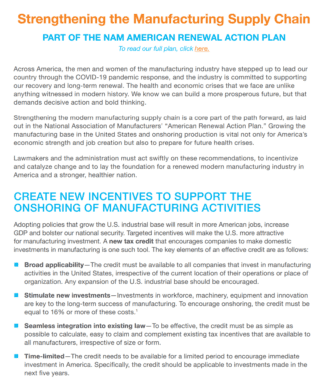
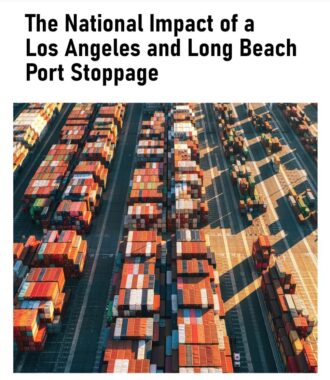

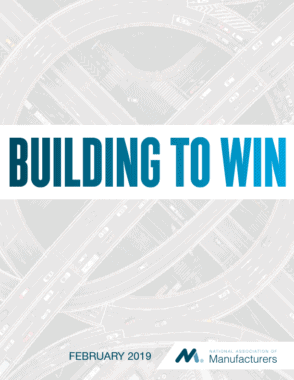
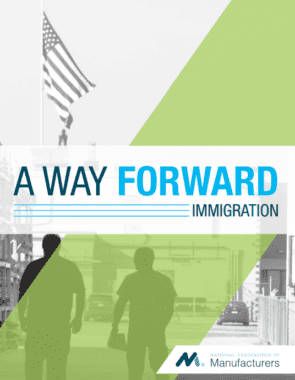

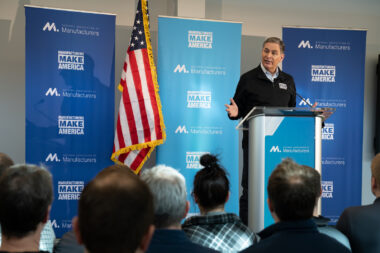 Take a look at the critical resources and tools the NAM has produced to improve and enhance federal legislation and help manufacturers learn more about policies that are shaping supply chain resiliency, innovation and future production.
Take a look at the critical resources and tools the NAM has produced to improve and enhance federal legislation and help manufacturers learn more about policies that are shaping supply chain resiliency, innovation and future production. Through the Manufacturing Institute, the NAM’s Manufacturing Leadership Council, Innovation Research Interchange and the NAM Legal Center, the NAM is working to promote manufacturers’ operational excellence and drive industry transformation needed to help address the supply chain crisis. Below are related NAM resources we encourage you to review:
Through the Manufacturing Institute, the NAM’s Manufacturing Leadership Council, Innovation Research Interchange and the NAM Legal Center, the NAM is working to promote manufacturers’ operational excellence and drive industry transformation needed to help address the supply chain crisis. Below are related NAM resources we encourage you to review:







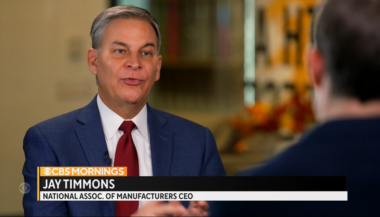 Don’t miss the latest news and insights from the NAM newsroom and the media on manufacturers’ work to improve our competitiveness through supply chain resiliency and across our infrastructure network.
Don’t miss the latest news and insights from the NAM newsroom and the media on manufacturers’ work to improve our competitiveness through supply chain resiliency and across our infrastructure network. WATCH: NAM President and CEO Jay Timmons joins MSNBC’s Morning Joe to discuss how increased cooperation between the U.S. and the eventual rebuilding of post-war Ukraine can also be vehicles for strengthening our global supply chain network and economy,
WATCH: NAM President and CEO Jay Timmons joins MSNBC’s Morning Joe to discuss how increased cooperation between the U.S. and the eventual rebuilding of post-war Ukraine can also be vehicles for strengthening our global supply chain network and economy,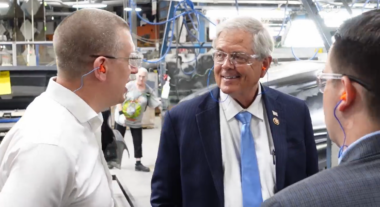 Next to friends and family, company leaders are the most trusted sources of information about issues shaping our industry.
Next to friends and family, company leaders are the most trusted sources of information about issues shaping our industry.